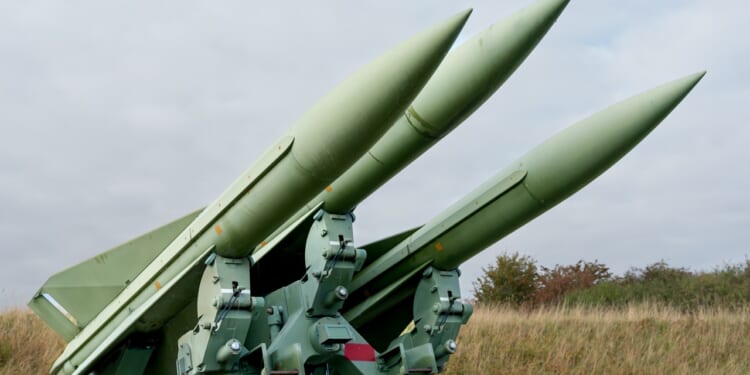In the opening hours of a US-China war, the DF-17 would crater runways at bases like Kadena in Japan or Andersen in Guam, crippling American airpower in the Indo-Pacific.
Quietly and without much media coverage, the Pentagon’s top military scientists are admitting that the People’s Republic of China (PRC) has leapfrogged Uncle Sam, despite the obvious spending gap between the two nations, in the key strategic domain of hypersonic weapons development.
Having poured the equivalent of $10 billion into developing not just a single, advanced hypersonic weapon but an entire ecosystem of such weapons, China has arrayed these lethal weapons along their anti-access/area-denial (A2/AD) zone of defense forward-deployed in places, like the South China Sea (SCS),where these systems can reach out and threaten distant US airbases and aircraft carriers.
America Doesn’t Have an Answer to China’s DF-17 Hypersonic Missile
The DF-17 (Dong Feng-17) is a medium-range ballistic missile system developed by China’s People’s Liberation Army Rocket Force (PLARF). It is notable for being one of the first operational hypersonic weapons in the world. The weapon was unveiled during China’s 70th anniversary military parade in October 2019 and is believed to have entered service around that time.
A solid-fueled, road-mobile missile, this weapon allows the PLARF to keep the weapon concealed, its transporter-erector-launcher (TEL) vehicle gives it rapid deployment capabilities. Because of this, the PLARF can employ “shoot-and-scoot” tactics to avoid detection and counterstrikes.
Weighing 33,069 pounds, this two-stage missile boosts a hypersonic glide vehicle (HGV), designated DF-ZF, to near-space altitudes before the HGV glides back to its target at hypersonic speeds. The system is designed to radically maneuver at those hypersonic speeds, making it nearly impossible for modern air defense systems to knock the HGV out of the air before hitting its intended target.
The DF-17 has an estimated range of 1,118-1,553 miles, making it suitable for regional strikes deep into the Indo-Pacific. The US military’s major hubs in the Indo-Pacific, including bases in Guam, Japan, South Korea, and the Philippines, are all within range. Speeds reach Mach 5 or higher, with some reports claiming the weapon maxes out at Mach 10 during glide phases.
How the DF-17 Missile Will Impact a Future War
In a hypothetical high-intensity conflict between China and the United States in the Western Pacific, the DF-17’s presence fundamentally shifts the balance of military power in China’s favor. These advantages would be felt especially in the opening phases of any such war.
Of course, China would need to do more than just hide behind their A2/AD bubbles. After all, there are other capabilities the Americans and their allies would bring to bear that might pop those bubbles. But the DF-17 certainly makes life difficult for American forces in the region and could prove decisive, if the other aspects of China’s military perform as intended in the opening phases of any such war.
In the opening hours of a US-China war, the DF-17 would crater runways at bases like Kadena in Japan or Andersen in Guam. What’s more, launching these weapons in large volleys at US aircraft carrier strike groups operating within range of the weapon could lead to those salvos overwhelming whatever defenses the carriers possess.
Therefore, the first casualty of any possible war with China could be one of America’s vaunted aircraft carriers. At the very least, the ship’s essential flight deck could be knocked out, rendering the carrier combat-ineffective, and thus essentially a loss from Beijing’s viewpoint.
In essence, the DF-17 enhances China’s ability to impose high costs upon any US military intervention in the area the weapon covers, potentially deterring it altogether or forcing the US to fight from farther away, reducing its effectiveness. Now, the Americans are far behind the Chinese—and the time to catch up is running out.
About the Author: Brandon J. Weichert
Brandon J. Weichert is a senior national security editor at The National Interest. Recently, Weichert became the host of The National Security Hour on America Outloud News and iHeartRadio, where he discusses national security policy every Wednesday at 8pm Eastern. He is also a contributor at Popular Mechanics and has consulted regularly with various government institutions and private organizations on geopolitical issues. Weichert’s writings have appeared in multiple publications, including The Washington Times, National Review, The American Spectator, MSN, The Asia Times, and others. His books include Winning Space: How America Remains a Superpower, Biohacked: China’s Race to Control Life, and The Shadow War: Iran’s Quest for Supremacy. His newest book, A Disaster of Our Own Making: How the West Lost Ukraine is available for purchase wherever books are sold. He can be followed via Twitter @WeTheBrandon.
Image: Shutterstock / Henrik A. Jonsson.















